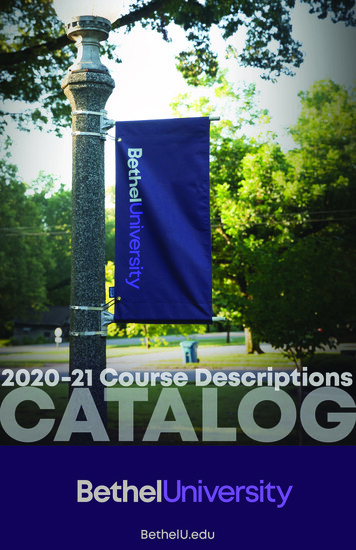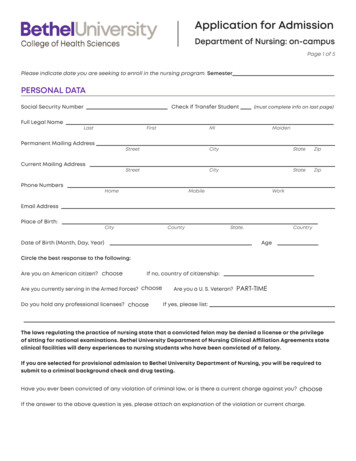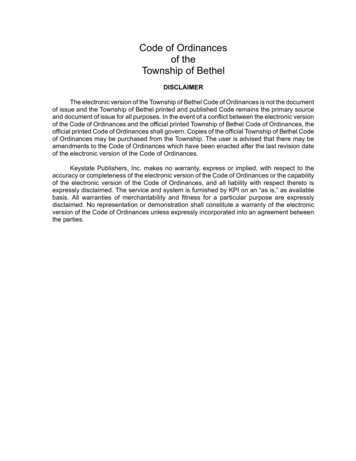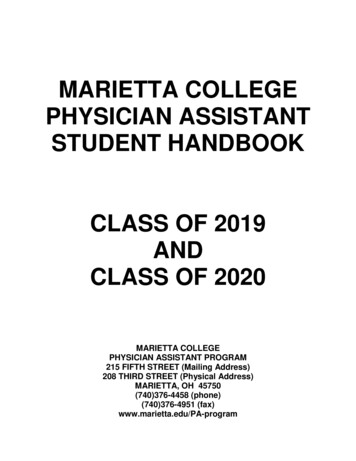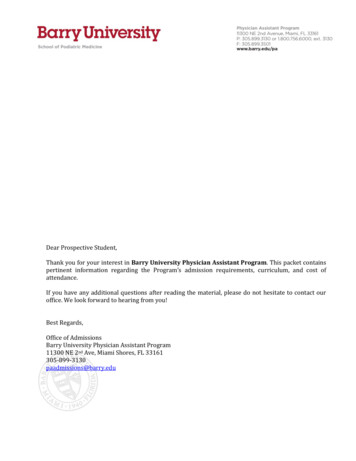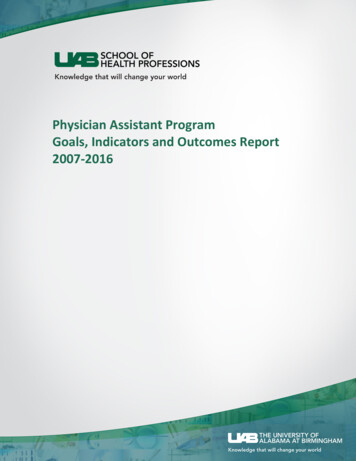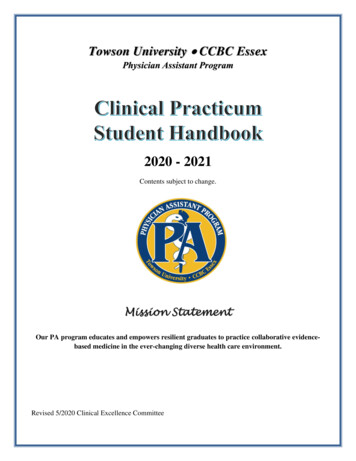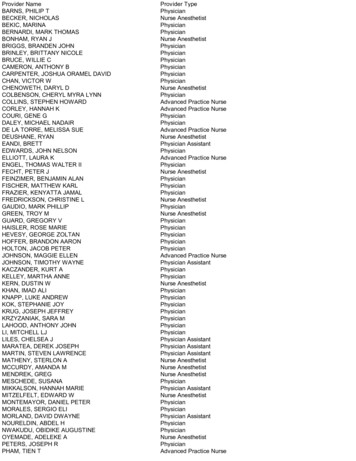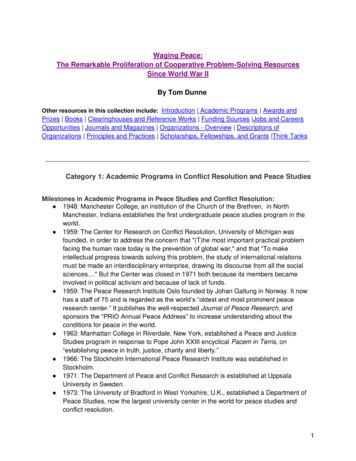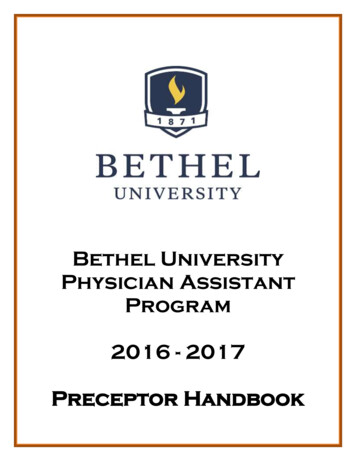
Transcription
Bethel UniversityPhysician AssistantProgram2016 - 2017Preceptor Handbook
Table of ContentsSECTION 1IntroductionFaculty and Staff Contact InformationThe One-Minute PreceptorClinical Year OverviewProgram InformationProfessional Responsibilities of a Physician ePage91010-12SECTION 2Preceptor Responsibilities and GuidelinesPA Program ResponsibilitiesStudent ResponsibilitiesStudent SupervisionStudent AvailabilityAcademic ResponsibilitiesStudent DressLiability InsuranceTroubleshootingProgram Harassment PoliciesEvaluationsStudent EvaluationPreceptor EvaluationsEnd of Rotation ExaminationClinical Skills TestingRotation Logs (eMedley)Student Rotation Work ScheduleStudent Attendance FormSite Visit for the StudentRemoval from RotationContinuing Medical Education for PreceptorPage 12Page 2-2324SECTION 3Rotation ObjectivesSECTION 4FormsMid-Rotation Preceptor Evaluation of StudentEnd of Rotation Preceptor Evaluation of StudentStudent EvaluationClinical Year CalendarAPPENDICIES2
SECTION 1IntroductionThe Bethel University Physician Assistant program is grateful for your contribution to thetraining of its students and the promotion of the physician assistant profession. BethelUniversity is committed to being the premier physician assistant training program in thestate and region.This handbook is designed to answer the questions that preceptors frequently have aboutPA training, the Bethel University PA Program, and the PA profession. The informationincluded provides a basic framework to assist preceptors in planning a comprehensiveclinical experience for their physician assistant students.Our faculty and staff are committed to creating a positive clinical experience for both thestudent and preceptor. We have imparted a great deal of medical knowledge to thestudents during the didactic phase of their education. We look to you to help them applythat knowledge in the clinical setting and become competent and compassionate healthcareproviders.We ask that you make a concerted effort to engage the student in case discussions andcritical thinking. Those new to precepting may find the article, The One-Minute Preceptor,included on page five of this handbook to be helpful. Our students have access to a wealthof online educational resources through the Bethel library. As physician assistants, theywill be expected to commit to life-long learning and the practice of ethical evidence-basedmedicine. You may wish to task them with researching specific topics they encounter oryou feel are essential to their education as physician assistants.We look forward to working with you to produce Minnesota’s finest trained physicianassistants. Please feel free to contact us should you have any questions about your role asa preceptor or our expectations of the PA students.Gregory Ekbom, MDClinical CoordinatorPA Program, Bethel UniversityCynthia Goetz, PA-CCo-Clinical CoordinatorPA Program, Bethel UniversityWallace Boeve, Ed.D, PA-CProgram DirectorPA Program, Bethel University3
Faculty and Staff Contact InformationProgram DirectorWallace Boeve, Ed.D, PA-CTelephone:651 635 1013 office651 308 1398 cellEmail:w-boeve@bethel.eduMedical DirectorDaniel Leafblad, MDTelephone:651 635 8072 office651 335 6326 cellEmail:d-leafblad@bethel.eduClinical CoordinatorGregory Ekbom, MDTelephone:651 635 8044 office651 964 5166 cellEmail:g-ekbom@bethel.eduAcademic FacultyChristina Hanson, MSPA, PA-CTelephone:651 635 8042 officeEmail:c-hanson@bethel.eduJeanne Szarzynski, MSPA, PA-CTelephone:651 635 8002 officeEmail:j-szarzynski@bethel.eduLisa Naser, MSPA, PA-CTelephone:651 635 8679Email:l-naser@bethel.eduAcademic Faculty &Co-Clinical CoordinatorCynthia Goetz, MPAS, PA-CTelephone:651 638 6747 office612 581 3830 cellEmail:c-goetz@bethel.eduClinical Administrative AssistantDenise BrecheisenTelephone:651 638 6746Email:d-brecheisen@bethel.eduAdministrative AssistantJan JohnsonTelephone:Email:651 635 8074jc-johnson@bethel.eduMailing Address3900 Bethel DriveSaint Paul, Minnesota 55112-6999FacsimileOffice651 287 0824651 635 80744
The One-Minute PreceptorA Method for Efficient Evaluation & FeedbackThe one-minute preceptor is a strategy for structuring an interaction with the student. Itconsists of the following sequential steps:1. Getting the Student to Commitment So, what do you think is going on with this patient? How would you like to treat this patient? Why do you think the patient came in today? What would you like to accomplish on this visit?2. Probe for Supportive Evidence – Evaluate Student’s thinking that leads to theCommitment How did you reach that conclusion?What made you ?What findings support your diagnosis?What else did you consider?3. Reinforce what was Correct – give Positive Feedback I agree with your interpretation.I am pleased that you included that aspect of the physical exam.I appreciate your consideration of the patient’s financial situation inprescribing .4. Constructive Guidance about Error or Omission – give Negative Feedback I disagree with the scope of your differential diagnosisWhat else might you have included?Including the abdominal exam would have been important A more efficient way to .5. Teach a General Principle – Clarify the Take-Home Lesson So in general, it’s important to remember It is always important to think about In general, taking a little more time Why don’t you read up on this tonight and report back tomorrow!Reference: Neher JO, Gordon KC, Meyer B, Stevens N. A Five-Step “Microskills” Model of Clinical Teaching.J Am Bd of Fam Pract July-Aug, 1992; Vol 5 No 4, 419-4245
Clinical Year OverviewRotations build on the didactic year and the students’ clinical experience is organized inambulatory, inpatient, emergency and surgical settings. The focus in all clinicalexperiences is medical care across the lifespan and includes: pregnancy, infants, children,adolescents, adults, and the elderly.During rotations, students learn the body of knowledge and clinical skills of each specialtywithin the framework of the health care team and PA role. Throughout the clinical year,students may be exposed to a variety of practice settings in rural, inner city, and medicallyunderserved communities.With the guidance and supervision of physicians, PAs, and other qualified preceptors,students gain higher levels of clinical skill and confidence. The PA Program providesstructured learning activities and timely feedback to students during the clinical year.Students assume increasing responsibilities for their education, provision of patient care,functioning as a team member, adjusting to change in the health care system, practice ofevidence-based medicine, and becoming lifelong learners.Program OverviewThe Bethel University Physician Assistant Program is a twenty-seven month professionaleducation program preparing individuals as primary care practitioners, to practice medicineunder the supervision of a physician. Students who successfully complete the programreceive a Master of Science – Physician Assistant degree (MS-PA).Mission StatementBoldly motivated by the Christian faith and in the spirit of Bethel University’s academicexcellence and ministry focus, the Physician Assistant program will educate students tobecome physician assistants who develop the skills for competent and excellent medicalpractice, live out ethical principles and Bethel’s academic excellence, serve theircommunity and all cultures, and possess integrity and compassion.Accreditation StatusThe ARC-PA has granted Accreditation-Provisional status to the Bethel UniversityPhysician Assistant Program sponsored by Bethel University. Accreditation-Provisional isan accreditation status granted when the plans and resource allocation, if fullyimplemented as planned, of a proposed program that has not yet enrolled students appearto demonstrate the program’s ability to meet the ARC-PA Standards or when a programholding AccreditationProvisional status appears to demonstrate continued progress in complying with theStandards as it prepares for the graduation of the first class (cohort) of students.Accreditation-Provisional does not ensure any subsequent accreditation status.6
It is limited to no more than five years from matriculation of the first class.Graduation from an accredited PA program is the only way to be eligible to sit for theNational Certifying Exam (PANCE). If granted provisional accreditation, graduates of theBethel University PA Program will be eligible to sit for the certifying exam upongraduation. For more information regarding the implications of accreditation please visitwww.arc-pa.org.Certification by the National Commission on Certificationof Physician Assistants (NCCPA)Physician assistants graduating from an accredited PA Program are eligible to sit for thecertifying examination administered by the NCCPA. The certifying examination is acomprehensive examination, administered via computer, testing didactic knowledge andproblem solving abilities. In order to maintain certification, PAs are required to obtain aminimum of 100 hours of continuing medical education (CME) every 2 years.Additionally, PAs must pass a recertification examination every ten years.The Didactic PhaseThe Physician Assistant Program at Bethel University consists of two phases. The firstphase is the didactic phase and is 15 months in length. Courses in this phase include:Gross Anatomy, Physiology, Pathophysiology, Clinical Medicine, Diagnostics,Pharmacology, PA Professional Issues, and Evidence-Based Medicine.The Clinical PhaseThe clinical phase directly follows the didactic phase and is 12 months in length. Theclinical phase takes place at diverse training sites and consists of a wide range of clinicallearning situations. The mandatory clinical rotations include: Family Medicine, InternalMedicine, Emergency Medicine, General Surgery, Pediatrics, Women’s Health, andBehavioral Health. Family Practice and Internal Medicine are 8 week rotations, while allothers rotations are four weeks in length. Additionally, students complete two electiverotations in their choice of disciplines.Each required rotation has a set of defined learning objectives. General objectives areprovided for the preceptors within this handbook and for the students within their ClinicalYear Student Handbook. Specific rotation expectations with minimum diagnosesexposures will also be provided to the preceptor under separate cover. These expectationsare not meant to be all-inclusive, but rather form a matrix of minimal exposure with whichthe student must be familiar or have completed during the clinical year.The end-learning objectives are written in a behavioral format wherever possible. The PAProgram seeks feedback from preceptors as well as students regarding the applicability oflearning objectives to the actual learning situation. Information from the preceptors, thePA students, as well as graduate PAs, will be taken into account during the annual reviewof objectives.7
Professional Responsibilities of the Physician AssistantPhysician Assistants are skilled members of the health care team qualified by academicand clinical experience to provide a broad range of health care services in practice with alicensed physician. These services may be provided to individuals of any age in thosevarious settings considered part of the supervising physician’s practice. The health careservices PAs provide include, but are not limited to:PA students are educated and trained to perform the following dutiesand tasks:1.Obtain Patient HistoryObjective focuses on skill in obtaining, documenting, and interpreting the patient’shistory, identifying pertinent factors, and interpreting risk factors.2.Perform Physical ExamObjective focuses on physical exam skills such as recognizing, interpreting, anddocumenting pertinent findings and using required techniques.3.Using Laboratory and Diagnostic StudiesObjective focuses on skill in selecting the appropriate studies, interpreting, anddocumenting the results.4.Formulating the Differential and Most Likely DiagnosisObjective focuses on skill in formulating and documenting the differential diagnosis andthe most likely diagnosis in light of history, physical or diagnostic test findings.5.Evaluating Severity of Patient’s ProblemsObjective focuses on skill in evaluating the severity of the condition and the need forfurther action.6.Management of Health Maintenance and Disease PreventionObjective focuses on skill in identifying risk factors and selecting appropriate preventivetherapeutic agents or techniques.7.Clinical InterventionObjective focuses on skill in prioritizing management and selecting the appropriatemedical and/or surgical treatment. Focus on determining the appropriate follow-upschedule or monitoring approach.8.Clinical TherapeuticsObjective focuses on skill in selecting the appropriate pharmacotherapy, recognizingactions of drugs, and educating patients about the effects of drugs and drug interactions.9.Legal/Ethical and Health Care SystemsObjective focuses on issues such as patient autonomy, PA/patient relationships,PA/physician relationships, and use of off-label or experimental therapies, end-of-lifeconsiderations, and treatment of minors.10.Applying Scientific Concepts (Basic Clinical Sciences &Research Data)Objective focuses on skill in identifying the processes responsible for a given condition.Focus on basic interpretation of research data and sensitivity and specificity of selectedtests.11.Work Related Behavioral ObjectivesThere are many work-related behaviors important to successful employment in healthcare.The following are some of the behaviors to consider when evaluating this student:productivity, work quality, initiative, teamwork, attitude, communication skills, and overallperformance as a potential employee.8
SECTION 2Preceptor Responsibilities1.2.3.4.5.6.Provide adequate clinical space for the student to care for patients.Ensure that students are not used as a substitute for clinical or administrative staff.Review and sign all of the student’s patient records within 24 hours.Familiarize each student with the protocols, rules, and regulations of the facility.Maintain administrative and professional supervision of the student while on duty.Provide direct supervision by qualified staff while the student is performingprocedures.7. Provide students with dressing and eating facilities similar to those of employees.8. Allow students to participate in and attend education offerings by and at the facility.9. Notify the Clinical Coordinator in a timely manner of any unsatisfactory conduct orperformance.10. Provide evaluations for each student on PA program forms. Allow and providestudents with opportunities to meet objectives.11. Provide PA program faculty access to the student, preceptor, and facility.12. In the event of an accident or sudden illness, the student will be allowed to seekmedical attention at the facility or an emergency room where the provider on duty willdetermine the course of treatment. Cost of the injury or sudden illness is the soleresponsibility of the student. In regards to the management of minor or chronicillness, PA students are advised that preceptors are not required nor encouraged toprovide care for the student, pro bono or otherwise.13. Maintain full responsibility for the patient’s medical care and treatment.14. Orient student to the safety and security measures of the clinical site.Preceptor GuidelinesThe majority of clinical assignments run smoothly and are both challenging and rewarding.However, the few words of caution listed below will be of value in helping to ensure asuccessful experience for both preceptor and PA student.The following guidelines are suggested for the preceptor when supervising a PA student:1. Expect students to perform similar to a third or fourth year medical student. If thestudent shows any serious deficiency or is in danger of not achieving the learningobjectives or failing the rotation, please promptly notify the Clinical Coordinator.2. Contact the Clinical Coordinator for clarification of matters relating to the rotation.3. Notify the hospital, clinics, and nursing homes that you will be a preceptor. Inquireabout policies and regulations governing PA students in all facilities.4. Ensure that only medical tasks delegated by you are performed by the student andthat services rendered by the student are regularly evaluated.5. Judge the student’s performance according to the objectives and goals set by theprogram for the clinical rotation.6. Involve the student in all aspects of the practice, including hospital and nursinghome services, so that the students will receive a well-rounded education.9
PA Program Responsibilities1. Provide the preceptor with the student’s educational objectives.2. Assume responsibility for selection and assignment of students to the individualpreceptor.3. Coordinate the educational and clinical activities involving the preceptor, clinicalfacility, student, and PA program faculty.4. Make training guides, evaluation measures, and other materials available to thepreceptor.5. Provide information at appropriate intervals to the student and preceptor regardingevaluation outcomes.6. Inform students on rotations they are subject to the policies, protocols, rules, andregulations of the preceptor and clinical facility.7. Be responsible for informing students that they are responsible for their own meals,lodging, transportation, uniforms, laundry, health and liability insurance for therotation.8. Bethel University requires that each PA student carries professional liabilitycoverage, are up to date on all program required immunizations (includingvaccinations or screenings), have completed a criminal background check, havepassed a drug screen, have completed HIPAA training, and are currently certified inBCLS and ACLS.9. Require students to attend any site provided or sponsored infection control sessionregarding universal precautions, TB, and blood borne pathogens.Student Responsibilities1. Report patient data fully to the preceptor.2. Proceed with management of the patient only after consulting with the preceptor.3. Act as a responsible health care provider by behaving professionally, legally, andethically at all times.4. Arrange schedule in advance and promptly notify the preceptor and the ClinicalCoordinator of any schedule changes.5. Wear an identification badge and white lab coat to identify themself as a BethelUniversity PA student when caring for patients.Student SupervisionStudents function within the academic policies established by the Bethel University PAProgram. Preceptors serve by providing clinical learning experiences, direction, andsupervision of students during the clinical rotation. The degree of responsibility delegatedto a student depends on the student’s attitude and ability. Students have no responsibilityfor patients except when under the supervision of a preceptor. Students are not to practicemedicine without supervision.10
Students are specifically prohibited from the following:1. Initiating unsupervised or unauthorized patient care.2. Discussing physical findings, lab results, significance of historical data, or treatmentplan without prior discussion with the preceptor.3. Ordering lab or diagnostic studies without prior consultation with the preceptor.4. Dispensing or writing prescriptions without authorization and preceptor’s signature.5. Disobeying protocols, rules, or regulations governing PA students established by thepreceptor.6. Discharging a patient from the facility without the patient personally being seen andevaluated by the preceptor.7. Student documentation in the Electronic Medical Record may include specific areas,including Past, Family, and Social History, and complete Review of Systems, but thepreceptor must repeat and document History of Present Illness, relevant PhysicalExam, and perform medical decision-making according to CMS regulations.Student AvailabilityStudents should experience a varied, but fairly typical exposure to your practice. Studentsare expected to be available and in close association with preceptors during practice hours.Students should accompany preceptors to hospitals, operating rooms, nursing homes, andother practice settings. Evening and weekend learning experiences are beneficial to thestudent so long as the total hours per week are not excessive. Students require time forindependent study, assignments, and preparation for the certification exam. If possible,limit student work time to 50 hours per week, with a minimum of at least 30 hours perweek.Student DressWhile on rotations students will wear a short white lab coat with the program patch on thepocket and name tag identifying them as a Physician Assistant student from the BethelUniversity PA Program. Students are instructed to always dress in a professional manner.If you have questions or concern with respect to certain student attire, please contact theClinical Coordinator or the program office.Academic ResponsibilitiesStudents learn at different rates, but students must assume an active role in education. Thestudent is expected to show initiative by asking questions, completing assignments,following patients, and giving feedback concerning how well the clinical rotation ismeeting objectives. Students take examinations at the end of rotations on materialspertinent to medical practice and patient care. The examination material may or may notbe related to a specific rotation.11
Liability InsuranceBethel University maintains proof of PA student liability insurance and a copy is availableto preceptors. Please notify your insurance carrier you are a preceptor for PA students.Insurance companies generally accept the presence of PA students without difficulty. PAstudents are covered for liability related to their normal curriculum studies andassignments. Limits of professional liability are , and paid for byBethel University PA program.TroubleshootingThe Clinical Coordinator and/or Program Director must be aware of any student problems.If you have concerns about a student’s professional behavior, academic ability, or clinicalskills, please contact us immediately. We are prepared to take an active role to improvedifficult situations. In the rare case when problems arise, preceptors can expect a prompt,dependable, and competent response.The PA program maintains regular contact with students and preceptors. Regularcommunication is intended to facilitate relationships among students, preceptors, and thePA program. Communication provides a mechanism for addressing informal questionsabout teaching, learning, and evaluation processes. Preceptors may contact the ClinicalCoordinator and/or Program Director at any time with questions or comments. Studentsare expected to contact the program with questions or problems.Harassment PoliciesMedical offices, operating rooms, emergency rooms, and hospitals are all institutionswhere the very serious business of taking care of people’s health and lives occur.Employees often use humor as a means of stress relief; however, their humor should nevermake another person feel as though they have been harassed or create a hostile workenvironment. Bethel University policy states that students should never be engaged in orexposed to behavior that would constitute harassment.Sexual HarassmentBethel University recognizes that harassment on the basis of sex is a violation of the law.We are committed to an environment free from explicit and/or implicit coercive sexualbehavior used to affect the well-being of members of this academic community. Sexualharassment is unacceptable and grounds for disciplinary action. Students who wish to filea complaint alleging Sexual Harassment should do so by contacting the ClinicalCoordinator or Program Director who will investigate and recommend appropriate steps.12
EvaluationStudent and Preceptor EvaluationsAll evaluations are done on eMedley.Preceptor or preceptor designee should meet with the student at the midpoint and near therotation end, discuss the student’s evaluation, fill out the evaluation forms, and sign themelectronically along with the student. The student is responsible for assuring thecompletion of the evaluation form(s) and submission to the Clinical Coordinator.Preceptors should review all evaluations even if preceptors have delegated the evaluationprocess to another provider.Evaluation should be an ongoing process beginning on the first clinical day, continuingthrough rotation completion. Evaluation is a two-way process. The preceptor evaluatesstudent performance and students evaluate rotations. Feedback is an art. Please provideongoing evaluation in a constructive and thoughtful manner.Student evaluation consists of preceptor evaluations, written examinations, rotation logs,and case presentations.The program should be informed immediately if a student is performing unacceptably sothat corrective measures may be instituted.Written Examinations (End of Rotation Examinations)End of rotation examinations are weighted at 40% of rotation grade. The writtenexamination includes primary care topics pertinent to the NCCPA exam and medicalpractice. Students must score 80% or higher on the exam to successfully complete therotation.Rotation Logs (eMedley)Each student completes rotation logs via eMedley system. These logs allow studentclinical evaluation by monitoring patient load, patient problems, learning experiences,procedures performed, and other activities. The rotation logs are a requirement duringeach rotation and do not include any patient identifiers. The preceptor is encouraged toreview these logs with the student to ensure that the learning objectives of the rotation arebeing met.13
Site Visit for the StudentA Bethel University PA Program faculty member will visit students during rotations. Thesite visit evaluates the student’s patient interactions and clinical reasoning as well as brieffeedback from the preceptors and office staff. Medical documentation may also bereviewed during the site visit. Visits may be announced or unannounced. At least one sitevisit will occur during the student’s clinical year, although more visits may occur at therequest of the student, preceptor, or faculty.If the visit is announced, the student notifies the preceptor ahead of time about the visit.When the faculty member arrives, the student introduces the faculty member to thepreceptor and to appropriate support personnel. The student should be prepared to answerquestions and present a case to the preceptor or faculty member. The student will discussthe treatment plan, evidence based issues, referrals, patient education and follow-upmanagement. Clinical site visits are graded as Pass or Fail based on objective performanceand preceptor comments. Students who receive a failing grade will have additional sitevisits during their rotations.Removal from Clinical RotationAny student who has willfully, accidentally, or unwittingly endangered the life of a patient,staff, peer, or him/herself during a rotation will be removed from the rotation immediately.The incident will be reported to the Clinical Coordinator and/or the Program Director forappropriate action.Bethel University PA program is particularly sensitive to any concern or issues that thepreceptor feels strongly should be addressed in an expeditious manner.The Clinical Coordinator, Medical Director, and Program Director retain the authority toremove a student from class, clinical site, or other program or university function, ifindicated.14
SECTION 3General Rotation ObjectivesRotation objectives outline the duties and tasks defining the PA student areas of learning.Core objectives are pertinent to all clinical experiences and program outcomes. Theclinical rotations should provide the student with learning experiences relevant to entrylevel PA practice. The core rotations for the program include Family Medicine, InternalMedicine, Emergency Medicine, General Surgery, Women’s Health, Pediatrics, andBehavioral Health. Specific program expectations for a scheduled rotation will beprovided to each student and preceptor. These expectations are not meant to be allinclusive, but rather form a matrix of minimal exposure with which the student must befamiliar or have completed during the clinical year. Elective rotation objectives will besent out to the individual preceptor when scheduled.Course GoalsThe following is a general list of objectives that are to be met during each rotationregardless of the type of rotation. The rotation specific expectations will be providedunder separate cover.Identify and study the objectives listed below for the most common diseases andconditions encountered on rotation. The student will be able to identify the most common reported signs andsymptoms found on history taking when given a specific disease or disorder.(History & Physical Exam) The student will be able to formulate the differential and most likely diagnosiswhen given a specific clinical vignette. (Forming a differential diagnosis) The student will be able to distinguish the most appropriate diagnostics to orderand interpret for a specific disease/diagnosis. (Diagnostics) The student will be able to select the treatment of choice (medication, physicaltherapy ) for a specific disease or disorder. (Treatment) The student will be able to assess specific classes of pharmacologic agentsalong with their indications, contraindications, side effects/complications, andlab evaluations for commonly seen disease or disorder. (Treatment) The student will be able to judge the criteria utilized to determine whetherhospitalization is required and subsequent discharge criteria for a specificdisease/diagnosis. (Treatment)15
The student will be able to evaluate the etiolo
The Bethel University Physician Assistant Program is a twenty-seven month professional education program preparing individuals as primary care practitioners, to practice medicine under the supervision of a physician. Students who successfully complete the program receive a Master of Science - Physician Assistant degree (MS-PA). Mission Statement


